What is a circlip?
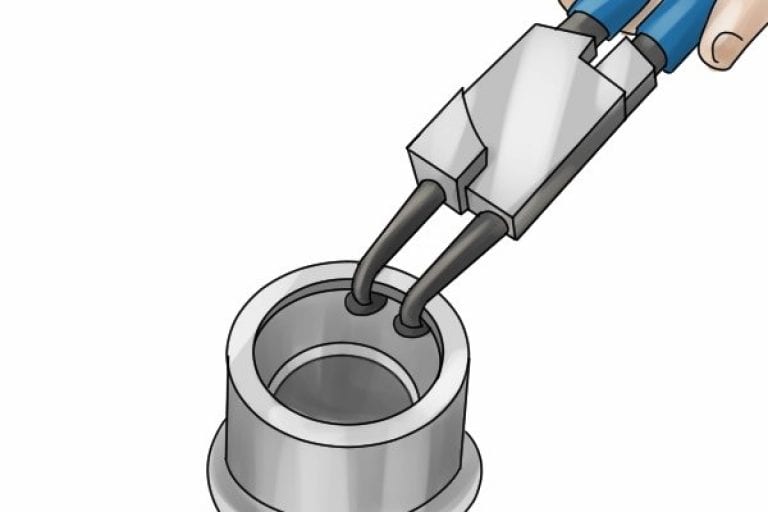
A circlip is a type of retaining ring or fastener that takes the form of a flexible, open-ended ring, made from metal. They may also be known as retaining rings, snap rings, c-clips, or Jesus clips.
Most applications which need a part to pivot, spin, or turn, where a bearing is used, will need a circlip or lock ring fastening. Circlips are commonly used in motors, turbines and pistons.
Circlips fit into a groove on the inside of a bore or the outside of a shaft. They work as a load-bearing shoulder which positions and holds mechanical parts. They provide continuous radial force and are secure against high rotational speeds because they are retained within the groove.
Internal and External Circlips
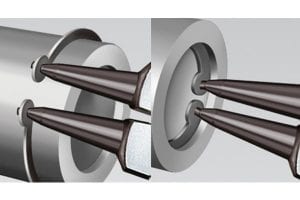
The two basic designs circlips come in are external and internal.
External circlips fit around a shaft, pressing on it, whilst internal circlips are fitted inside a cylindrical bore, or housing, and push outwards.
Usually, each opposing end of the ring will have a lug with a small hole through it. These holes are where circlip pliers’ tips fit to remove or install circlips, expanding or contracting the ring so it can fit in a groove inside a bore or around a shaft.
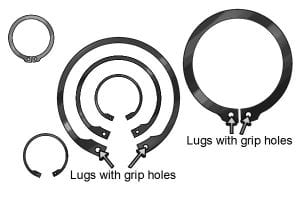
The open ends of the circlip create a spring pressure effect which allows them to fit securely into a grooved channel on a circular component. The pressure created by the spring will vary, depending on the thickness and diameter of the circlip.
There are many variations of external and internal circlip design, as they are used for many applications in industry and machinery. Circlips can come in sizes from around a millimetre to over a metre, and some large machines, such as wind turbines, use circlips over three metres in diameter.
Different Types of Circlips
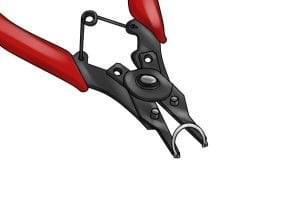
Although there are many variations of circlip, as they have so many different applications, there are a few basic designs you will come across.
Most of these retaining rings have a design of circlip pliers which can be used with them. However, some may need a different tool. There is a special e-clip installation tool which can be used with e-clips and most spiral retention rings can be installed manually.
Constant-Section Retaining Rings
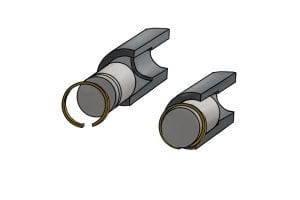
This is the most simple retaining ring, sometimes called a snap ring. It has a constant thickness from centre to ends. This means that when the circlip is either compressed or expanded, its shape changes slightly from circle to ellipse. This irregular shape means that the contact with the groove is not constant and will just occur at three or more points.
These do not have lugs which stick out, and are often used when a larger retaining ring is required. They don’t always have holes in the ends like standard circlips; instead, they may have grooves or flat ends.
Standard circlip pliers are not designed for use with these when they don’t have holes. However, there are retaining ring pliers with specially-shaped tips which can be used.
Spiral Retention Rings

Constant section rings are also available as a spiral version, which means they will maintain a full 360-degrees of contact once installed into or onto a shaft.
These cannot be installed with circlip pliers; instead, they are installed by hand, by separating the spiral and coiling the ring into the groove, or with a special plunge tool with a tapered plug.
Tapered-Section Circlips
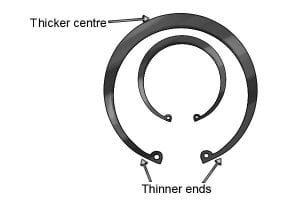
The most common type of circlip is called the ‘tapered-section circlip’. The thickness of the section tapers off towards its ends, so the centre is the thickest part of the circlip.
This means that the diameter of the circlip remains in a circle when compressed, or enlarged, to fit into or onto a shaft. Therefore, the circlip will hold maximum contact with the groove once it is installed.
Tapered-section circlips were a development of the constant-section retaining ring design, increasing their effectiveness as a fastening. These circlips were patented in 1927 by German, Hugo Heiermann, for the Seeger company. Circlip pliers are designed to be used with these circlips.
Inverted Circlips
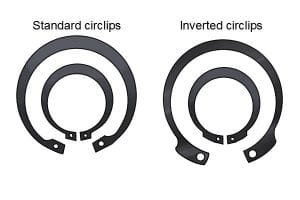
This is the most simple retaining ring, sometimes called a snap ring. It has a constant thickness from centre to ends. This means that when the circlip is either compressed or expanded, its shape changes slightly from circle to ellipse. This irregular shape means that the contact with the groove is not constant and will just occur at three or more points.
These do not have lugs which stick out, and are often used when a larger retaining ring is required. They don’t always have holes in the ends like standard circlips; instead, they may have grooves or flat ends.
Standard circlip pliers are not designed for use with these when they don’t have holes. However, there are retaining ring pliers with specially-shaped tips which can be used.
Increased Abutment Circlips

Sometimes called ‘star’ or ‘K’ circlips, these are similar to tapered section circlips but with extra lugs equally spaced around the circumference.
They are often used for holding machine parts which have large edge off-sets, bevels, or radiuses, as the extra lugs create a more even load distribution. Circlip pliers can be used with these.
Grip Rings
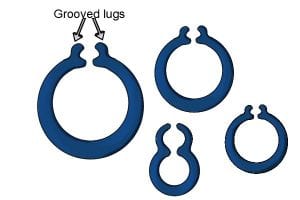
Similar to external circlips, grip rings fit onto shafts, but they don’t need to sit in a groove. These have a tighter grip, which keeps them steady on the shaft, but as a result they will not open as much as standard circlips, which usually makes them harder to remove or install.
These can usually be used with standard circlip pliers; the tips of the pliers can be used to pry open the ring using the grooves at the end of its lugs. Circlip pliers with a lock pin may be the best choice with these fastenings as the lock prevents overstretching.
E-Circlips
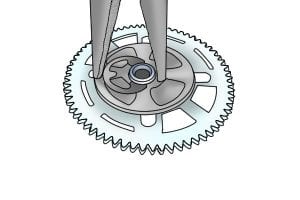
E-clips are fitted radially rather than axially, onto shafts. Similar to standard circlips, they fit in a groove. However, they do not have grip holes so can’t be used with circlip pliers. They can be installed by being pushed onto a shaft with a special tool, or pair of standard pliers.
As e-clips can be fitted radially, they can be installed or removed onto shafts even when being placed between other parts.






